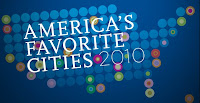President Obama's Deficit Commission will soon come out with
recommendations with how to reduce our national debt.
Here is a
draft of the power point presentation on their policy recommendations.
There are three proposals in particular that could have major implications for urban growth and walkable communities.
1. Eliminating the mortgage interest tax deduction
The mortgage interest tax deduction has helped subsidize home ownership, primarily in suburban areas. It has helped encourage larger houses, on larger lots, leading to more sprawl. Eliminating this at least removes the tax incentive to build bigger and gives a more level playing field for developers wanting to build denser housing projects.
2. Raising the gas tax 15 cents to pay for transportation costs.
While I'm sure this would be unpopular, this could get more people out of their cars and using mass transit, increasing riderships and perhaps justifying new transit lines and newer dense transit-oriented development. And the hope is that at least some of the revenue generated by the tax increase would help fund new transit lines.
3. Eliminating earmarks
I'm not sure if the Commission means eliminating all federal infrastructure projects entirely (and passing them onto states?). I suspect they mean adopting the infrastructure bank idea that used to have bipartisan support until some Republicans decided they didn't want to support anything supported by the President. The Infrastructure Bank would be an independent commission that would award federal funding on a more competitive base, leverage private money to put infrastructure projects where they would maximize investment, not based on the political process like they are now. This could dramatically help urban areas which need infrastructure projects the most, and we might see an end to major infrastructure projects in rural areas that help only a few residents but are built thanks to influential Congressmen (see the Bridge to Nowhere, for example)
These proposals face serious uphill battles to win approval as they will be very unpopular politically. But if politicians are willing to do the serious work this country needs to do to solve our deficit issues, urban areas could be the beneficiaries.
 It was a lively program featuring an interesting discussion of government officials, community activists, and regular citizens and brought focus to a sorely underdiscussed topic in this community - how will we grow?
It was a lively program featuring an interesting discussion of government officials, community activists, and regular citizens and brought focus to a sorely underdiscussed topic in this community - how will we grow?




